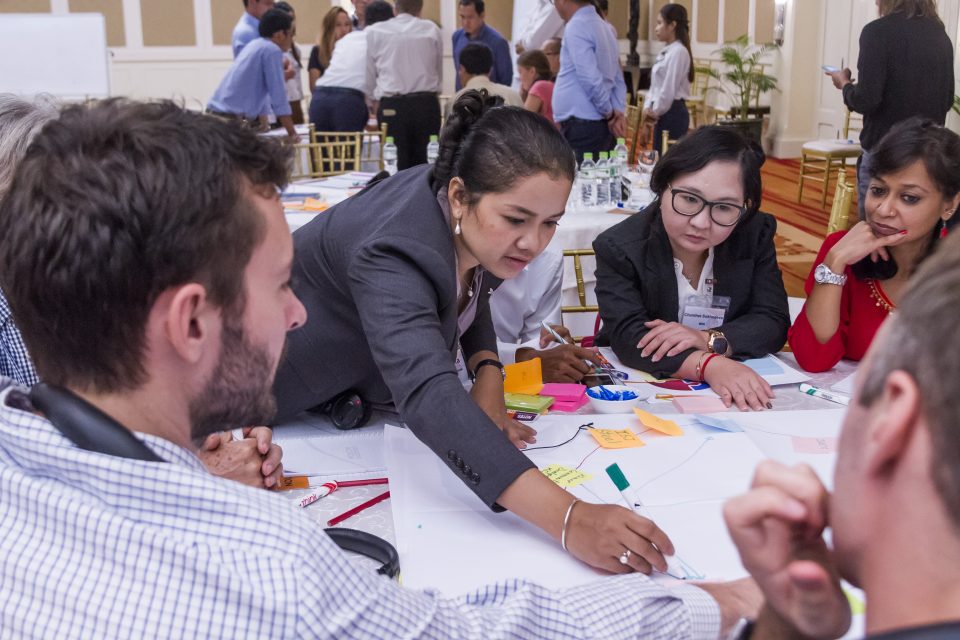Fostering Collective Action in the rural sanitation and hygiene sector in Cambodia
“Collective impact is fundamentally not about creating a whole new initiative,
but rather connecting and strengthening existing efforts and filling gaps.”
[Committing to Collective Impact, FSG 2014]
That was the theme behind the first Collective Action Workshop held in Phnom Penh, Cambodia last month. Dozens of actors from Cambodia’s rural water, sanitation, and hygiene [WASH] sector came together to chart a more collaborative effort towards meeting the sector’s shared vision of universal sanitation by 2025 and the goals outlined in the 2014 – 2018 National Action Plan [NAP].
As Mr Chreay Pom, Director of Cambodia’s Department of Rural Health Care, highlighted in his keynote address, this wasn’t the first, nor the only, instance of a collaborative approach to deal with the most critical issues facing the sector. Cambodia’s RWSSH Strategy and RWSSH National Action Plan [NAP] – the very documents that guide the sector – were developed with input from multiple stakeholders. There are committees and working groups at national and sub-national levels that serve as platforms to inform and connect organizations. And working groups meet regularly to discuss pressing issues such as fecal sludge management or behaviour change communication (BCC).
These collaborative efforts have paved the way for WASH organizations to work smarter at tackling open defecation. And it has proven effective. Over the last decade, Cambodia’s rural families have adopted toilets at an unprecedented rate, pushing sanitation coverage in rural villages from 25 percent to more than 50 percent and rising.
While there are several mechanisms in place for collaboration, hundreds of organizations continue to rely on ad-hoc cooperation; new players coming into the space have no central hub for information on current activities and existing research; and stakeholders are rarely able to avoid costly duplication or to find ways to align their work and create synergies.
The sector has reached an inflection point. In order to follow the steep curve from 50 percent coverage to universal sanitation in the next decade, there is an urgent need to invest in dedicated support and deliberate, systematic facilitation that will allow actors to optimize their use of existing mechanisms, collaborative more effectively than in the past, and use resources much more efficiently.
As the opening quote suggests, Collective Action is not about forging a new path for the sector, rather it’s about leveraging the structures already in place and finding ways to make the existing network more dynamic and able to innovate in response to challenges. Essential questions to answer will include: Are there critical issues that are being overlooked? Where do overlapping or duplicated efforts occur? Are the necessary stakeholders at the table, not only government and NGOs, but also donors, private companies, and academic institutions? And importantly, how does the sector ensure the NAP is realized?
This workshop was the first step in laying the foundation for the Collective Action approach. Stakeholders from multiple sectors spent the day discussing how their organization’s activities align with the sector vision for universal sanitation and the barriers preventing the sector from reaching the vision. Importantly, it was a day spent fostering new and ongoing relationships amongst sector peers in the private, public, and academic spheres, identifying where they converge, and how they can work better together.
What’s in place and working: the National Action Plan
The morning kicked off with Mr. Chreay Pom, Director of Rural Health Care at the Ministry of Rural Development, giving a review of the objectives of the National Action Plan – the government’s guiding document for the WASH sector, released in January 2016:
1. Enabling environment – capacity development and institutional arrangements
2. Mobilizing resources
3. Strengthening and providing a sustained and comprehensive water supply
4. Ensuring communities have sustained access to improved sanitation
5. Behaviour Change Communication [BCC]
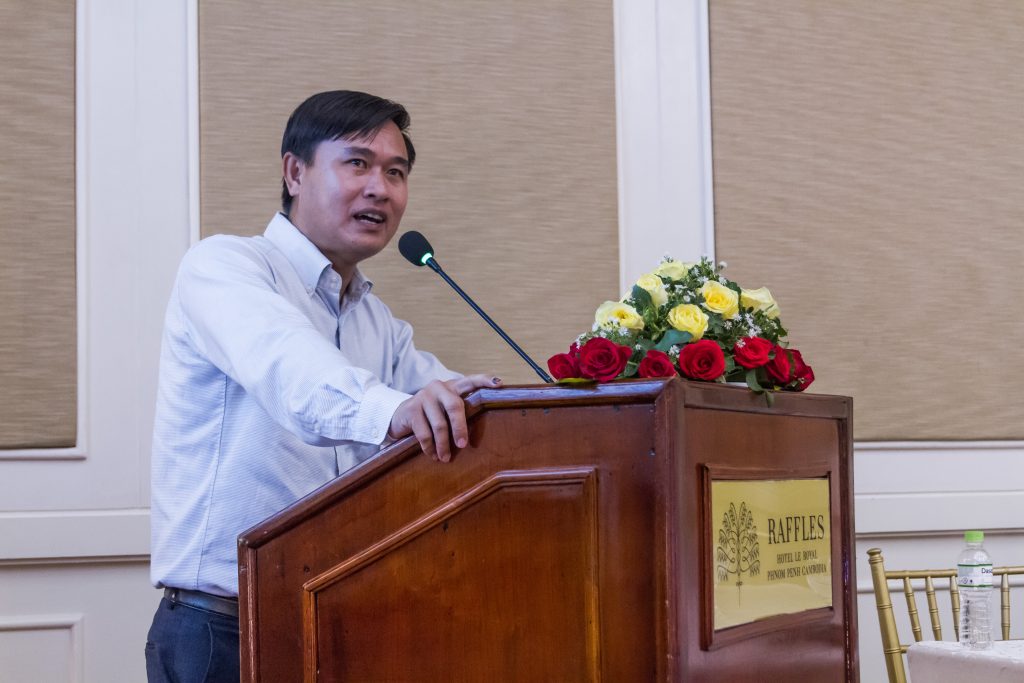
Mr. Pom explained that the government used a participatory approach to consolidate the most critical WASH issues into the National Action Plan. The process challenged stakeholders to take a hard look at what was and what wasn’t working for rural families to have access to sustained sanitation services. “Before, the focus was on providing families [subsidized] latrines. But we found that people were using latrines to store rice or feed for their livestock,” explained Mr. Pom. “We realized it wasn’t a successful strategy. We introduced CLTS and linked that with sanitation marketing which has been successful. And we stopped subsidies except those targeting the poorest populations.”
The realization by sector stakeholders to pivot away from subsidies towards CLTS and sanitation marketing has resulted in a positive and rapid uptake of latrines. Mr. Pom said Cambodia is on track to surpass the 2018 goal of 60 percent rural sanitation coverage. But he cautioned that the uphill climb to reach the 2025 goal is only getting steeper and will require “a new way of thinking” to reach the very top.
Reflections: How do stakeholders currently align with the National Action Plan
The morning continued with brainstorming sessions about how to align activities with the National Action Plan. Three questions were posed to groups of ten throughout the morning:
1. How does the sector vision guide your work or approach?
2. What would it take for your organization to fully align with the sector vision?
3. What can we do to overcome barriers to achieve the 2025 vision?
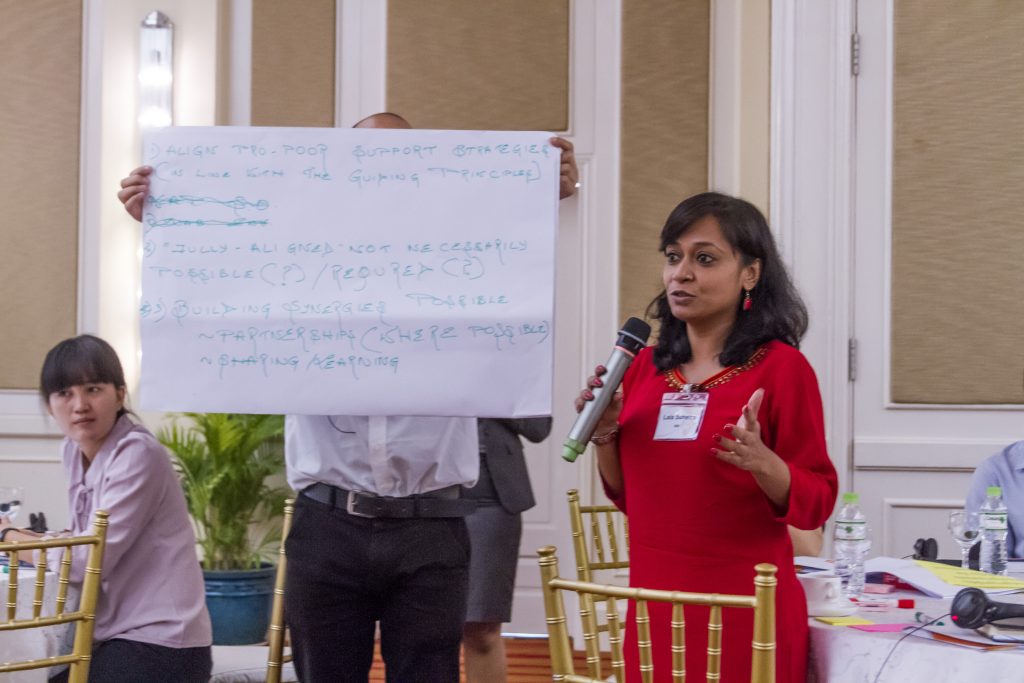
Group discussions unveiled patterns weaved throughout each answer. “We need rigorous research and reliable data.” Organizations repeatedly echoed this sentiment, pointing to standardized indicators and shared data as an opportunity for better collaboration. “If we have enough data, we can see what are the most needed interventions and which are not needed.”
Despite having a guiding document, participants expressed concern that they are typically working in silos towards the vision outlined in the NAP. This has frequently led to duplicated efforts across the same geographical areas, or worse, methodologies that without thoughtful application, contradict each other. “If we have appropriate maps and sector wide data available, new partners that want to work on sanitation can see if that target area has NGOs already working in it.” Another group concurred. “Building synergies is needed and partnerships are needed so we don’t start each project from the ground up.”
To collect reliable data that will inform the sector, workshop participants agreed that government at the national and sub-national levels need more resources and capacity to collect and disseminate information. “We need to build capacity at the commune and sangkat level. [Local councillors] are the important actors to implement the NAP and reach our vision. They need a better understanding of the national policy and strategy.”
Organizations also pointed to the need for better engagement with the private sector and donors – the former for innovative ideas in product and service design and the latter to be better aligned with sector strategies. “We need to educate donors about the best practice to follow. Although they may have good intention to help, they may not realize that there are better ways to do it. It’s useful if we can speak with one voice to those unaligned donors that there is a shared strategy they can follow.”
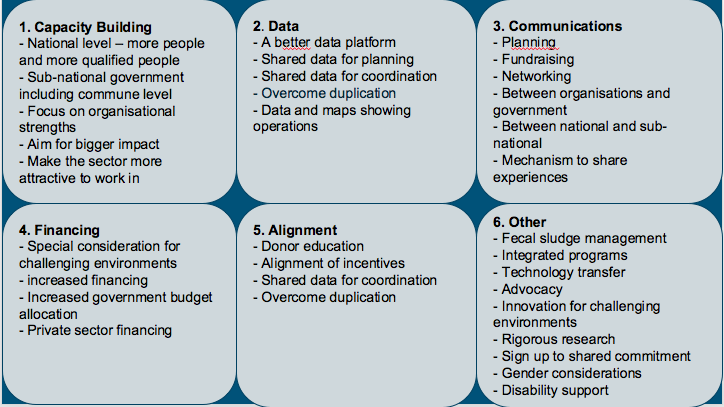
Many critical questions remained unanswered. Should the sector stop activities that are not fully aligned and not part of the NAP? How does the sector align methodologies so different approaches are not in conflict and organizations avoid duplicating efforts in similar geographies? And which issues should the sector tackle first with finite resources?
To begin answering these questions, the RuSH group will conduct an Organizational Network Analysis (ONA) and systems mapping exercise to gain insights into how stakeholders interact with each other. The analysis will identify the actors that influence or play a role in achieving the 2025 vision, and shed light on how they collaborate and share information to achieve that vision.
Mapping pre-existing networks
To conduct the Organizational Network Analysis, Cambodia’s rural sanitation and hygiene sub-group (RuSH) is turning to LINC – a US-based company that develops tools to map organizational networks and to leverage systems-based approaches for development. At the workshop, LINC started the afternoon session with a series of activities that helped participants visualize what it means to have a shared vision and work together towards that shared vision.
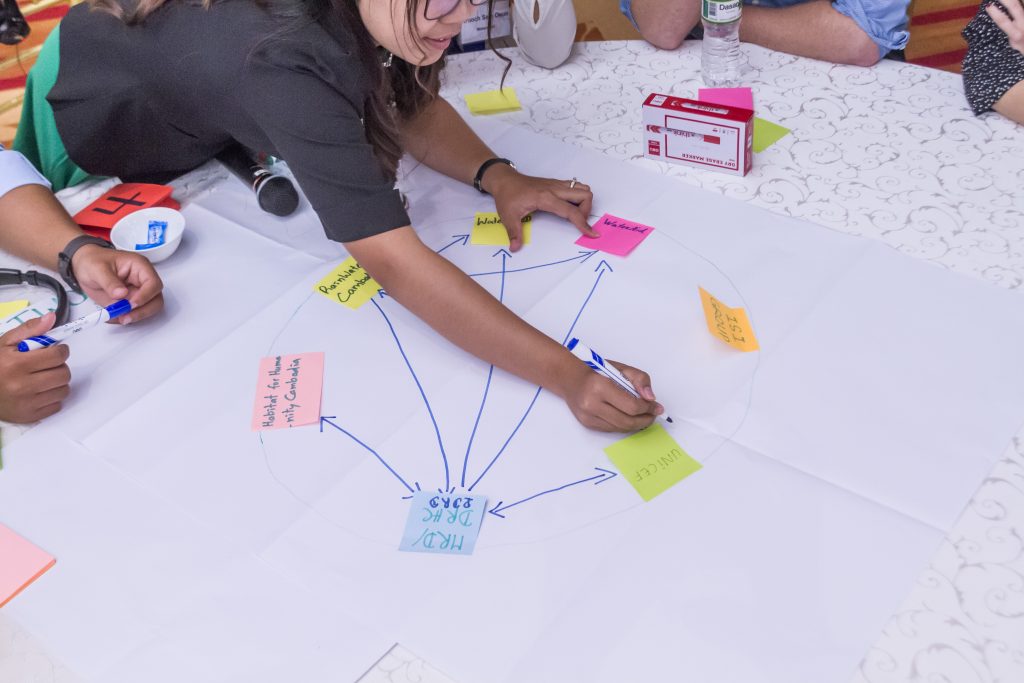
Networks, of course, vary in complexity, density, and number of connections. But more of each does not necessarily lead to a better functioning network. “Would it be more efficient if there was a hub that collects all the information and disperses it accordingly?” asked Mr. Fromer. “Which organizations can play specific roles? One organization can’t do it all. We need to figure out who works in which roles. Central actors are important.”
It’s challenging work ahead for the sector. To achieve universal sanitation in the next decade, what should Cambodia’s RuSH network look like and what shape should it take over time? Networks are fluid, remarked a participant. We can continue to shape it and change how it works in order to meet sector needs.
Where do we go from here?
In the next two months, LINC will support the RuSH network to:
1. Identify organizations that fit within the network boundary: the ONA requires a clear network boundary to avoid getting too big. “It can expand so much that the information that comes out is no longer valuable,” explained Mr. Fromer. The boundary for this network analysis requires organizations to 1) have a presence in Phnom Penh, and 2) one of the following: a) have a mission or strategy that includes a focus on RuSH; b) have at least three staff working 50 percent or more of their time on RuSH activities; or c) allocate more than USD $25,000 of their annual budget to RuSH activities.
2. Conduct interviews: a group of enumerators will visit more than 100 organizations that appear to meet the network boundary set out above. The enumerators will ask a series of questions to understand existing relationships as well as how organizations see the current challenges and issues in the RuSH sub-sector.
3. Analyse data and report: results will include, for example, which actors are the most connected; which act as a good bridges between stakeholders; if relationships are typically reciprocal, and how aligned actors are in achieving the RuSH sub-sector vision.
The results of the interviews will be revealed in September at a follow up workshop. From there, the sector will embark on the next phase of Collective Action: identifying areas to strengthen and critical leverage points; and how to shape the relationships within the RuSH network to achieve more effective results. In the meantime a sector support group, also know as a “backbone” team, will help drive the priority actions identified by members and support the work of specific technical groups. “Collective Action is a tool to see if existing mechanisms are working,” said Dr. Samnang, National Coordinator of WSSCC, in his closing remarks. “We have technical working groups at all levels including WATSAN and other sub-groups. But we need to strengthen these mechanisms to improve and promote what we are doing.”
See you in September.

